1999-2004 (Return to Web Text-ures) |
Click Here to return to
|
1999-2004 (Return to Web Text-ures) |
Click Here to return to
|
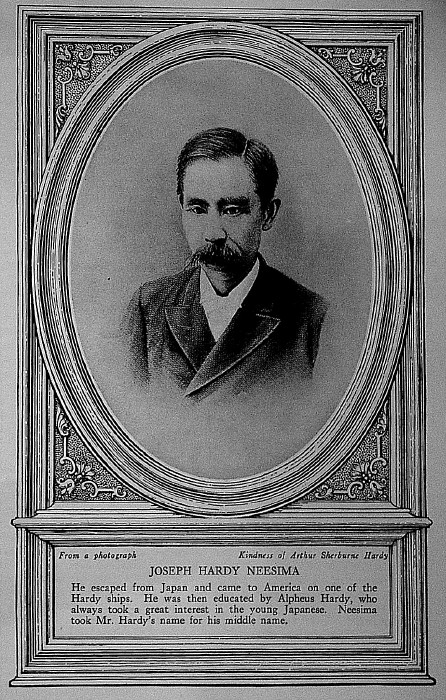
From a photograph
Kindness of Arthur Sherburne Hardy
JOSEPH HARDY NEESIMA
He escaped from Japan and came to America on one of the Hardy ships. He was then educated by Alpheus Hardy, who always took a great interest in the young Japanese. Neesima took Mr. Hardy's name for his middle name.
Alpheus Hardy and Ezra
Baker in the early forties were successful in the coastwise trade, so much so,
in fact, that for the purpose of extending their commerce they purchased the
"Otho," a little brig of 150 tons, to send to the Mediterranean, and although
she was very small the merchants of Boston looked with jealous eye upon her. The
"Otho" made a remarkable trip, and arrived in Boston long before the rest of the
fleet. At once her cargo was advertised at auction, and buyers thronged the pier
where old John Tyler was reaping fancy prices, when in the midst of the sale one
of Boston's merchants drove up in a chaise and called out to the crowd: "Buy
easy, boys, buy easy! My bark is just signalled, and she will be here before
night." Perhaps the sale would have terminated more successfully had the buyers
known that this bark had not signalled, and that a fortnight was to elapse
before she appeared in port. In spite of this misfortune which attended the
disposition of the "Otho's" first cargo under her new ownership, the firm of
Hardy and Baker prospered, and became a worthy predecessor of the later firm of
Alpheus Hardy & Co. The latter firm had the distinction of owning many swift
vessels. They also never sold a ship nor changed a flag through fear of either
foreign or domestic foe, and perhaps as a reward they never lost a ship to the
Confederates during the Rebellion. Their ships included the "Conquest," "Ocean
Pearl," "Cowper," "Granite," "Wild Rover," and "Mountain Wave," and their barks
were the "Young Turk," "Kepler," "Cleber," "Wild Gazelle," "The Turk," "Bounding
Billow," "Daniel Webster," "Dorchester," and "Young Turk, 2nd." The "Daniel
Webster" owned by the Hardy firm was usually the ship that brought the first
cargo of fruit into the Boston market, a coveted honor among the vessels of
those days. She was later owned by John S. Emery & Co. of Boston.
In a letter written by
Alpheus Hardy at Gibraltar, November 20, 1845, he said: "I sailed from our good
city, the Queen city of the States. My leaving was under the most pleasing and
happy circumstances, so far as conveyance and company were concerned, our firm
having prepared a new bark completely fitted for our comfort. My pride was moved
by going in my own vessel, and with a cargo under my control. Poor human
nature!" During this tour made by Mr. Hardy to the Nile and the Holy Land, ships
belonging to the firm were frequently met with, and in them were sent home many
purchases, and mementos of travel.
It was the "Wild Rover"
belonging to Alpheus Hardy & Co. that in 1865 brought into the United States the
first Japanese to come to this country in search of learning, and it was Alpheus
Hardy who became the benefactor of and who educated Joseph Hardy Neesima, the
young immigrant, and who lived to see his protégé serve Japan and there found
Doshisha University. Neesima's escape from Japan to China was made in an
American vessel of which William T. Savory of Salem, Mass., was master. Captain
Savory kindly consented to aid the young Japanese, and, in order to secure his
safety from the custom-house officers, locked Neesima in the store-room of the
cabin. At Shanghai, Neesima was transferred to the Hardy ship "Wild Rover,"
commanded by Captain Horace S. Taylor of Chatham, Mass., and after a prolonged
voyage of eight months the vessel reached Cape Cod. When the young Japanese came
on board he could speak only a few words of English, and when he was asked his
name by the captain he replied that it was "Neesima Shimeta." "I think I had
better call you Joe," rejoined the captain, and from that time he was known by
that name. Upon meeting Neesima in Boston, Alpheus Hardy undertook the education
of the young foreigner who had risked his life to come here in search of
knowledge. He was placed in Phillips Academy at Andover, and afterwards was sent
to Amherst College, where he was graduated in 1870. He is remembered as the
Apostle to Japan. Up to Mr. Hardy's death in 1887 his interest in Neesima's work
was very great. Professor T. Makino and Professor Mizusaki, who have been living
in Boston recently, were two of Neesima's pall-bearers when he died in 1890.
Alpheus H. Hardy succeeded
his father as a member of the firm of Alpheus Hardy & Co. The younger Mr. Hardy
in 1853 -- when but thirteen years of age -- crossed the Atlantic in the 320-ton
bark "Young Turk" belonging to his father and manned by a Chatham crew. During
this voyage young Hardy kept a diary in which he recorded impressions of the sea
and of places visited, his last entry, November 9, 1853, giving a vivid picture
of the lad's joy in seeing Boston again. "On Long Wharf," he says, "I recognized
father among the crowd, and also the blacks (black horses) and mother's face at
the carriage window. I touched the wharf before the ship and was soon out of the
crowd and where in comparative seclusion, I might be welcomed at home."
At the two hundredth anniversary of Chatham, Mass., in 1912, Mr. Hardy recalled this early voyage. "In the years," said Mr. Hardy, "when we still owned ships, so far as possible, we chose Chatham or Cape men as masters. Among them was John Paine, to whom was gladly paid a higher wage if he would take his wife with him; David Nye Nickerson, Thomas Crowell, Thomas Sparrow, Andrew Reynolds and others. The choice was based upon the confidence and belief in the character and ability of the men. In connection with this, let me mention an incident which occurred this morning. Captain Ephraim Smith told me that my father told him when he had chartered him for a special voyage, 'I have not chartered your vessel, but you.' It was not the ship, but the but the man he wanted. I recall the unwillingness to let the now Rev. S. S. Nickerson go to sea in command of the 'Heroine,' which he had chartered, because of his extreme youthful appearance, until he learned that he was a Chatham boy. That settled it, and he made a successful voyage."
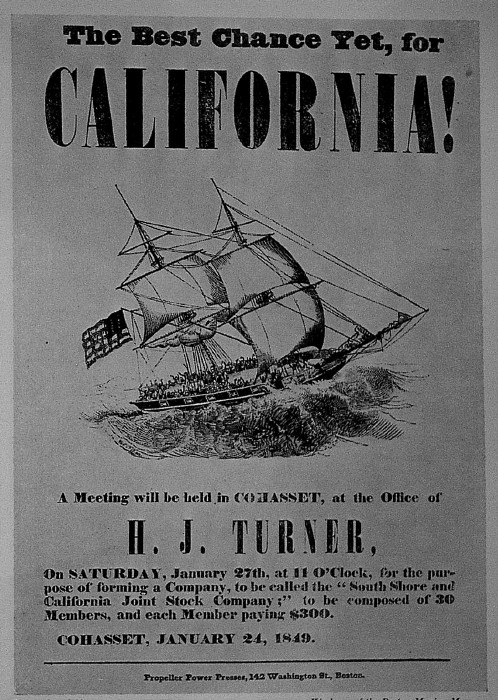
In this year 775 vessels cleared from Atlantic ports for San Francisco, Massachusetts sending 224. 91,405 people arrived in the Golden City during the year 1849.
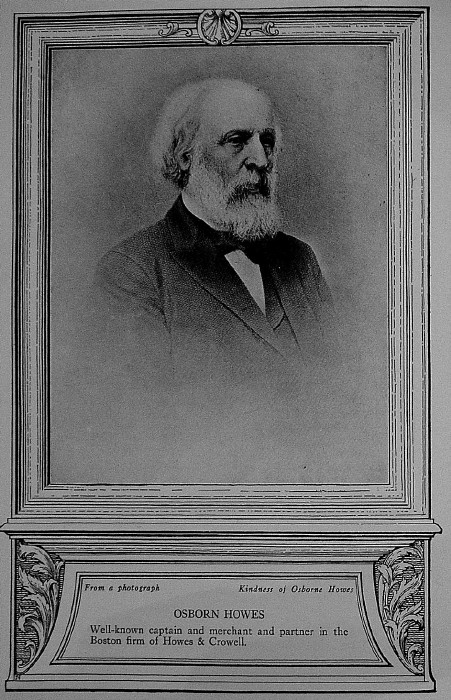
From photograph Kindness
of
Osborn
Howes
OSBORN HOWES
Osborn Howes was born in
Dennis, Mass., in 1806, the family having settled on Cape Cod as early as 1635.
His father, who was also a well-known sea-captain, was captured by the English
during the war of 1812, but managed to escape, and succeeded in recapturing his
own vessel, bringing her and her crew back into Portland Harbour. Nothing could
be more interesting than the description in Mr. Howes' autobiography of his
early life on Cape Cod, which pictures his mother spinning and weaving the
clothing for the whole household, while the son wound quills and attended to the
farm.
In 1818 the Howes family
put all their property on board a small schooner and sailed to Boston, going to
Dedham by stage-coach, where they took up their residence, the younger Howes
journeying to the new home on top of a pile of furniture which was placed on the
ox-cart. The trip consumed all of the day and part of the night.
At an early age he was
sent by his father, who sailed ships for Edmund Baylies and Thomas B. Curtis, to
Copenhagen under Captain Burgess. The second voyage was as supercargo in the
"Cipher," which had been commanded by his father. Several years later David
Ellis asked him to take the bark "Hebe" to Brazil, expressing this promotion by
saying that he could not afford to pay the salaries of both a captain and
supercargo, and that he would therefore have to act in both capacities. Howes,
of course, was overjoyed and, with an interest in the undertaking, sailed for
Pernambuco. On his return he purchased the remaining interest in the "Hebe" and
made several successful voyages in her, one of them being to Turkey, where he
was hailed as the first American captain to visit that country. He then took his
brother-in-law into partnership, forming the firm of Howes & Crowell, which
continued in business for thirty-four years. The "Josephine," "George Hallett,"
"Newton," and "Osborne Howes " also carried the flag of the firm. The business
of the house increased at the time of the gold craze in California, and many
vessels owned by them were employed in trade with California, China, Australia,
and Western Europe. During the latter years of Captain Howes' life he was
persuaded to manage the American Steamboat Company and to invest in some of its
stock. The enterprise proved unprofitable, and Mr. Howes had to give all his
energy at an advanced age to wind up the affairs of the Company, the strain on
his physique being very severe.
In 1874 he foresaw the
wane of shipping investments and spent the next few years of his life in selling
his vessels.
When he died, an intimate
friend of his said, "To have known him was a great privilege; to have had
personal acquaintance with him was to believe forever in the men who made us a
nation, and consequently to have faith in its future."
For many years Howes and his family shared a house on Fort Hill with Captain Ezra H. Baker. The family now spells the name Osborne
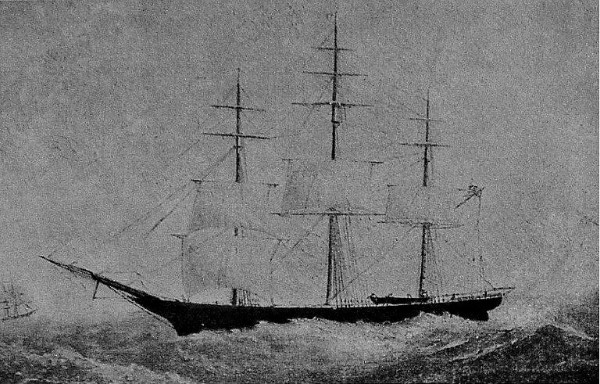
From
a print
Kindness
of Louis Bacon
This famous dipper was owned by Daniel C. Bacon and was built by Samuel Hall. She was one of the fastest vessels ever built. Her figurehead of a Game Cock with outstretched neck and head was known to many ports of the world.
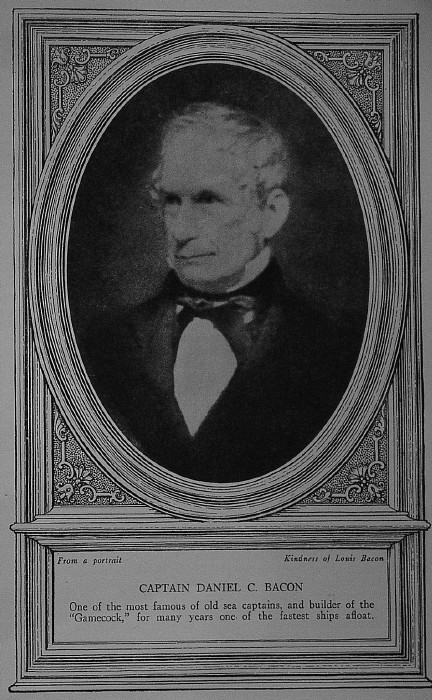
From a portrait
Kindness of
Louis Bacon
CAPTAIN DANIEL C. BACON
The "Canton Packet" while
in China, in 1820, was blown ashore by a typhoon, which left her almost high and
dry on the rice-fields. Daniel Bacon had gone over as captain of the "Alert,"
and as soon as he discovered the mishap he rushed over to assist in floating the
American vessel. He gave orders to one of the sailors to "bear a hand and loose
that topsail" and "to cut away the stops," and was surprised to receive the
answer that it couldn't be done, as he had no knife. "A pretty sailor without a
knife," said Captain Bacon, not realizing at all that he was working with and
talking to Robert Bennet Forbes, who was soon to become his most intimate
friend. In fact, the two families have always maintained that in later life when
either of these well-known captains was taking a nap, each one gave instructions
to be waked only for his chum.
Captain Bacon was born in
Barnstable, Cape Cod, the family having moved there from England in 1639, and
the property where they resided still remains in the family, although the
original house is not now standing. At this early date the Cape-Codders used to
refer to "Goodman" and "Goodwife" instead of "Mr." and "Mrs." When the first
railroad was built on the Cape, the Bacons relate that one of the women of the
family had such an aversion to its being laid that when she went out to drive
she carried a large turkey-feather fan to hold in front of her eyes so that she
couldn't see the trains go by. Life on the Cape was excellent training for the
sea, and it wasn't at all surprising that one of the later members of the
family, Daniel Bacon, should at an early age set out on the old family white
horse for Boston to seek his fortune as a sailor, hiring some one to ride his
horse back to Barnstable. He shipped before the mast, rising quickly in rank
until he became first mate under Captain William Sturgis, and then captain of
vessels owned by Ropes & Pickman and by Theodore Lyman, both of whom were
prominent merchants of this city. Bacon sailed several times under Captain
Sturgis, and when the latter was married, the two brought their ditty-bags and
sewed together the carpet for the bride to stand upon. It is interesting to
record that, nearly a century later, a marriage took place between two of their
grandchildren.
Captain Bacon commanded
the "Atahualpa," the "Vancouver," the "Alert," and other ships, and later in
life built the well-known "Gamecock," one of the first of the California
clippers, and other vessels for his own use. For many years the "Gamecock" was
the fastest ship afloat, and it was probably this vessel that prompted the
famous challenge for a match race which was made to British shipbuilding in 1851
by the American Navigation Club, of which Bacon was president. The "Gamecock"
had a figurehead of a flying bird with outstretched neck and head, ready for any
contest. Captain Bacon besides being a successful captain was also a good
trader, which was just as important in the early days of trading, when great
judgment and secrecy had to be used. The "Gamecock" is shown on page 30.
An amusing entry in
Captain Bacon's log of the "Atahualpa " reads, "All sail set that is of the
least use to drive us along toward the Yankee lasses." A later entry, which
rather disclaims this fondness for the fair sex, reads, "It is so fine and
smooth that I should like to have about forty or fifty pretty lasses on board
for two or three hours upon a tea-drinking party, if there is any pleasure in
them, but for my own part, I had rather be excused any time than to go to one of
them."
Long after Captain Bacon
gave up the sea, Mrs. George Lyman, daughter-in-law of Theodore Lyman, became
very ill and was ordered by her physician to go to Cuba. She refused to go
unless Captain Bacon sailed her down, and, being of an obliging disposition, he
donned his sea togs again and took her to Cuba, together with her carriage and
horses. Another time he was obliged to undergo a severe operation, before the
days of anaesthetics. Dr. Warren tied him down and operated on his patient, who
suffered terribly. When it was over, Bacon said jokingly, "Dr. Warren, if I ever
get you on blue water, I'll give you hell!"
An interesting incident in
his life was the lodging of the Siamese twins in his woodshed, they having been
brought to America as a speculation by Captain Abel Coffin, one of Bacon's
under-officers. Daniel Bacon has been described as the "synonym of mercantile
enterprise, honor and integrity." Captain Forbes when told that he had died of
enlargement of the heart remarked that this was impossible, for his heart
couldn't be any larger than it always had been.
The family lived at one
time in Temple Place, later moving to Jamaica Plain near the Pond.
A prized possession is a silver tray service given Captain Bacon by the underwriters for saving the cargo of his vessel which went ashore in a storm at Nantasket. Young Bacon hired an ox-team and drove back and forth through the icy water until all the cargo was safely on shore.
"Commodore" Forbes, or "the seamen's friend," as he was often called, went to sea at the age of thirteen, had been captured three times by the British before he was nine years old while travelling with his mother, and commanded the "Canton Packet" when lie was only twenty, thereby fulfilling the fondest dream of a boy of those days. Throughout his career he always lived up to the advice given to him by Captain William Sturgis: "Always go straight forward, and if you meet the Devil cut him in two and go between the pieces; if any one imposes on you, tell him to whistle against a Northeaster, and to bottle up moonshine." Captain Forbes, or "Black Ben," as he was also often called, was a merchant as well as a sailor, and was a partner of Russell & Co. for some years. As was the case with so many men of his day, when he or his mother needed any money it was a question of another trip to China. The point of view at the present time is in great contrast to the ideas expressed in his memoirs, in which he wrote, "Looking back to 1824 when I was content in the command of a little ship of 264 tons, on a salary of six hundred dollars per annum, I conceded that I had arrived at the acme of my hopes." "Commodore" Forbes built and sailed many ships. When the well-known clipper "Paul Jones" was launched in Medford, a number of Captain Forbes's friends were present to witness the event. No wine was served for lunch, and when one of the guests was asked by the "Commodore" how he liked the vessel, he replied, "I think she is going to be a d--d dry ship." Another time when sailing to China as a passenger in the " Mary Chilton " a Chinese pilot hove in sight, remarking, "Missee Captain, you must take in that stu'n sail, plenty lock (rock) here, stlong tide." The Captain then asked how much the Chinaman wanted for taking the ship to Hong Kong, to which he replied, "Ole Flen [friend] askee hundred dollah, welly cheap!" "Commodore" Forbes, who knew every inch of the China coast, approached at this point in the conversation and was recognized by the pilot, who immediately changed his figures, exclaiming, "Hi-yah, ole Foxe! Ten dollah can do, Missee Captain." Even at this reduced price the pilot was unnecessary.
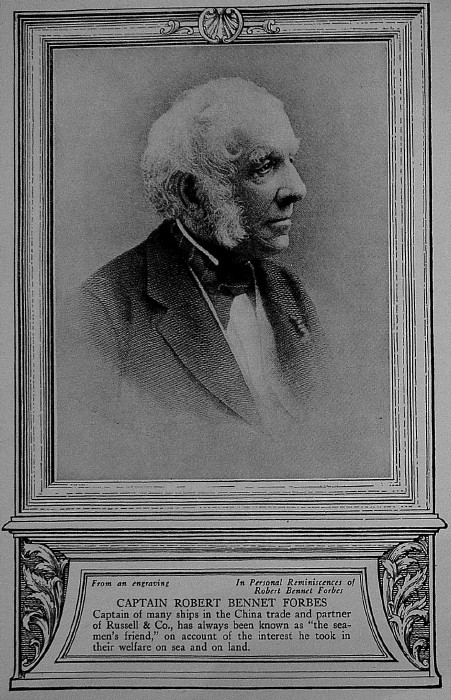
From an engraving In
Personal Reminiscences of
Robert Bennet Forbes
CAPTAIN
ROBERT BENNET FORBES
Captain of many ships in the China trade and partner of Russell & Co, has always been known as "the seamen's friend," on account of the interest he took in their welfare on sea and on land.
So fond was Captain Forbes
of anything pertaining to the sea
that he built port-holes
around the upper part of his house on Milton Hill to make his house on land seem
more like his home on the sea. He occupied a great deal of his time in making
models of ships for the boys of Boston and Milton; when a boy grew to a certain
mark on the wall of the workshop he was entitled to one of these miniature
sail-boats, and, as they were much prized, many a boy tried to tiptoe to make
himself tall enough to get the coveted boat.
"Commodore" Forbes led a
life full of excitement and adventure. He was interested in over seventy
vessels; commanded the "Jamestown," which took provisions to the Irish during
the famine of 1847; hunted in Pau when over sixty-five years old; founded the
Sailors' Snug Harbour, in Quincy; superintended the building of gunboats for
our Government during the war; and when the "Europa" ran into and sank the
"Charles Bartlett" in mid-ocean he jumped into the sea and saved many lives, for
which he received several medals.
He once wrote to a friend that he expected him to jingle a marlinespike on his monument at Forest Hills before many days. Through some mistake this remark got into the newspaper and therefore the "Commodore" was obliged to write again. "Dear old sinner," he said, "since the report of my serious illness I have been obliged to hire a police officer to stand at the front door and reply to the numerous kind enquiries as to my condition. The Smiths and the Joneses, undertakers, have been looking around expecting a job! My daughter telegraphs for particulars and has prepared her kit to leave Iowa; my servants have given warning, alleging they cannot be kept running to the front door to answer the bell; I have been so worried that I have been obliged to call in Dr. Watson; my credit at the banks has suffered, and, worse than all, my creditors, the butcher, the baker, and the grocer, have sent in their bills! I am still living and have bought a six-shooter, so be on your guard." A short time before his death, when a friend was calling upon him, he said, "I have gone down to the docks, and I am waiting for the old ferryman to carry me over." His dying wish was that the following words be placed on his tombstone: "He tried to do his duty."